| Republic of Maldives ދިވެހިރާއްޖޭގެ ޖުމްހޫރިއްޔާ (Dhivehi Raa'jeyge Jumhooriyya) | ||||||
|---|---|---|---|---|---|---|
| ||||||
| Anthem: Qaumii salaam "National Salute" | ||||||
| Capital | Malé 4°10′N 73°30′E / 4.167°N 73.5°E | |||||
| Official language(s) | Dhivehi | |||||
| Ethnic groups | ≈100% Dhivehis [1][2][3] (Excluding Foreigners) | |||||
| Demonym | Maldivian | |||||
| Government | Presidential republic | |||||
| - | President | Mohamed Nasheed | ||||
| - | Vice President | Mohammed Waheed Hassan | ||||
| - | Speaker of the Majlis | Abdulla Shahid | ||||
| - | Chief Justice | Ahmed Faiz[4] | ||||
| Independent | ||||||
| - | from United Kingdom | 26 July 1965 | ||||
| Area | ||||||
| - | Total | 298 km2 (206th) 115 sq mi | ||||
| - | Water (%) | ≈100% (land negligible) | ||||
| Population | ||||||
| - | 2010 estimate | 396,334[5] (176th1) | ||||
| - | 2006 census | 298,968[6] | ||||
| - | Density | 1,036.9/km2 (11th) 2,866.9/sq mi | ||||
| GDP (PPP) | 2010 estimate | |||||
| - | Total | $2.734 billion[7] | ||||
| - | Per capita | $8,541[7] | ||||
| GDP (nominal) | 2010 estimate | |||||
| - | Total | $1.870 billion[7] | ||||
| - | Per capita | $5,841[7] | ||||
| HDI (2010) | ||||||
| Currency | Maldivian Rufiyaa (MVR) | |||||
| Time zone | (UTC+5) | |||||
| Drives on the | left | |||||
| ISO 3166 code | MV | |||||
| Internet TLD | .mv | |||||
| Calling code | 960 | |||||
The Maldives (![]() i /ˈmɒldaɪvz/ or /ˈmɒldiːvz/), (Dhivehi: ދިވެހިރާއްޖެ , Dhivehi Raa'je), officially Republic of Maldives (Dhivehi: ދިވެހިރާއްޖޭގެ ޖުމްހޫރިއްޔާ , Dhivehi Raa'jeyge Jumhooriyya), also referred to as the Maldive Islands, is an island nation in the Indian Ocean formed by a double chain of twenty-six atolls stretching in a north-south direction off India's Lakshadweep islands, between Minicoy Island and Chagos Archipelago. It stands in the Laccadive Sea, about seven hundred kilometers (435 mi) south-west of Sri Lanka and (250 mi) south-west of India. During the colonial era, the Dutch referred to the country as "Maldivische Eilanden" in their documentation, while "Maldive Islands" is the anglicised version of the local name used by the British, which later came to be written "Maldives".
i /ˈmɒldaɪvz/ or /ˈmɒldiːvz/), (Dhivehi: ދިވެހިރާއްޖެ , Dhivehi Raa'je), officially Republic of Maldives (Dhivehi: ދިވެހިރާއްޖޭގެ ޖުމްހޫރިއްޔާ , Dhivehi Raa'jeyge Jumhooriyya), also referred to as the Maldive Islands, is an island nation in the Indian Ocean formed by a double chain of twenty-six atolls stretching in a north-south direction off India's Lakshadweep islands, between Minicoy Island and Chagos Archipelago. It stands in the Laccadive Sea, about seven hundred kilometers (435 mi) south-west of Sri Lanka and (250 mi) south-west of India. During the colonial era, the Dutch referred to the country as "Maldivische Eilanden" in their documentation, while "Maldive Islands" is the anglicised version of the local name used by the British, which later came to be written "Maldives".
This chain of islands is an archipelago located among the Lakshadweep-Maldives-Chagos Group, which are in reality the tops of a vast undersea mountain range, in the Indian Ocean and the Arabian Sea.[9] The atolls of the Maldives encompass a territory spread over roughly 90,000 square kilometres, making it one of the most dispersed countries in the world in geographic terms. It features 1,192 islands, of which two hundred are inhabited.[10] The Republic of Maldives's capital and largest city is Malé, with a population of 103,693 (2006). It is located at the southern edge of North Malé Atoll, in the Kaafu Atoll. It is also one of the Administrative divisions of the Maldives. Traditionally it was the King's Island, from where the ancient Maldive Royal dynasties ruled and where the palace was located.
The Maldives are the smallest Asian country in both population and land area. With an average ground level of 1.5 metres (4 ft 11 in) above sea level, it is the lowest country on the planet.[11] It is also the country with the lowest highest point in the world, at 2.3 metres (7 ft 7 in)[11] such that rising sea levels are a great concern for the Maldives.
Contents[hide] |
Etymology
The name Maldives may derive from Mahal'deeb, and the people were called Maldivian 'Dhivehin'. The word Dheeb/Deeb (archaic Dhivehi, related to Sanskrit dvīp (द्वीप)) means "island", and Dhives (Dhivehin) means "islanders" (in other words, the Maldivians). During the colonial era, the Dutch referred to the country as Maldivische Eilanden in their documentation, while Maldive Islands is the anglicised version of the local name used by the British, which later came to be written as "Maldives".[citation needed]
The ancient Sri Lankan chronicle, The Mahawamsa, refers to an island called Mahiladiva ("Island of Women", ंअहिलदिभ) in Pali, which is probably a mistranslation of the same Sanskrit word meaning "garland". The Mahawamsa is derived from an even older Sinhala work dating back to the 2nd century BC.[citation needed]
Some scholars theorise that the name Maldives derives from the Sanskrit mālādvīpa (मालाद्वीप), meaning "garland of islands".[12] None of the names are mentioned in any literature, but classical Sanskrit texts dating back to the Vedic times mention the "Hundred Thousand Islands" (Lakshadweepa), a generic name which would include not only the Maldives, but also the Laccadives, Amindivi Islands, Minicoy and the Chagos island groups.[13]
Some medieval travelers such as Ibn Batuta called the islands "Mahal Dibiyat" (محل دبيأت) from the Arabic word Mahal ("palace"), which must be what the Moorish Berber traveller interpreted of the local name having been through Muslim North India, where Perso-Arabic words were introduced into the local vocabulary .[14] This is the name currently inscribed in the scroll of the Maldive state emblem. The classical Persian/Arabic name for Maldives is Dibajat.[15][16]
Philostorgius, an Arian Greek historian who relates (circa AD 354) about a Divoeis (the Divaeans) hostage after fulfilling his mission to the Homerites, sailed to his island home known as Divus (Maldives).[17] The name Maldives also might have come from the Sinhalese word මාල දිවයින Maala Divaina ("Necklace Islands"), perhaps referring to the shape of the archipelago.[citation needed]
The local language of Maldives which is now called "Dhivehi" could have come from the Sanskrit word "Daivehi" meaning "Godly". Even after the development of Dhivehi and its Arabic look alike alphabets, most of its words are similar in pronunciation and meaning to words in Hindi or other Prakrit language which has its origin in Sanskrit in turn.
Geography
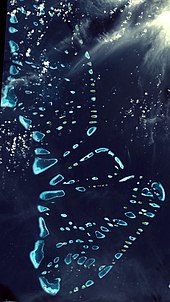
The Maldives consists of approximately 1,190 coral islands grouped in a double chain of 26 atolls, along the north-south direction, spread over roughly 90,000 square kilometres, making this one of the most dispersed countries in the world. It lies between latitudes 1°S and 8°N, and longitudes 72° and 74°E. The atolls are composed of live coral reefs and sand bars, situated atop a submarine ridge 960 kilometres long that rises abruptly from the depths of the Indian Ocean and runs from north to south. Only near the southern end of this natural coral barricade do two open passages permit safe ship navigation from one side of the Indian Ocean to the other through the territorial waters of Maldives. For administrative purposes the Maldivian government organized these atolls into twenty one administrative divisions. The largest island of Maldives is Gan, which belongs to Laamu Atoll or Hahdhummathi Maldives. In Addu Atoll the westernmost islands are connected by roads over the reef and the total length of the road is 14 km (9 mi).[citation needed]
The Maldives is the lowest country in the world, with a maximum natural ground level of only 2.3 metres (7 ft 7 in), with the average being only 1.5 metres (4 ft 11 in) above sea level, although in areas where construction exists, this has been increased to several metres. More than 80 per cent of the country's land, composed of coral islands scattered over an area about 850 km across the equator, is less than one metre above sea level.[18]
The reef is composed of coral debris and living coral. This acts as a natural barrier against the sea, forming lagoons. Other islands, set at a distance and parallel to the reef, have their own protective fringe of reef. An opening in the surrounding coral barrier allows access to the calmer lagoon waters. The barrier reefs of the islands protect them from the storms and high waves of the Indian Ocean.[citation needed]
A layer of humus 15 centimetres (6 in) thick forms the top layer of soil on the islands. Below the humus layer are 60 centimetres (2 ft) of sandstone, followed by sand and then fresh water. Due to high levels of salt in the soil near the beach, vegetation is limited there to a few plants such as shrubs, flowering plants, and small hedges. In the interior of the island, more vegetation such as mangrove and banyan grow. Coconut palms, the national tree, are able to grow almost everywhere on the islands and are integral to the lifestyle of the population.[citation needed]
The limited vegetation and land wildlife is supplemented by the abundance of marine life. The waters around the Maldives are abundant in rare species of biological and commercial value, with tuna fisheries being traditionally one of the main commercial resources of the country. The Maldives have an amazing diversity of sea life, with corals and over 2,000 species of fish, ranging from reef fish to reef sharks, moray eels, and a wide variety of rays: Manta rays; Stingray; and Eagle ray. The Maldivian waters are also home for the whale shark.[citation needed]
Climate
The Indian Ocean has a great effect on the climate of the country by acting as a heat buffer, absorbing, storing, and slowly releasing the tropical heat. The temperature of Maldives ranges between 24 °C (75 °F) and 33 °C (91 °F) throughout the year. Although the humidity is relatively high, the constant cool sea breezes keep the air moving and the heat mitigated.[citation needed]
The weather in the Maldives is affected by the large landmass of South Asia to the north. The presence of this landmass causes differential heating of land and water. These factors set off a rush of moisture-rich air from the Indian Ocean over South Asia, resulting in the southwest monsoon. Two seasons dominate Maldives' weather: the dry season associated with the winter northeastern monsoon and the rainy season which brings strong winds and storms. The shift from the moist southwest monsoon to the dry northeast monsoon occurs during April and May. During this period, the northeast winds contribute to the formation of the northeast monsoon, which reaches Maldives in the beginning of June and lasts until the end of August. However, the weather patterns of Maldives do not always conform to the monsoon patterns of South Asia. The annual rainfall averages 2,540 millimetres in the north and 3,810 millimetres in the south.[citation needed]
Environmental Issues
| Wikinews has related news: Maldives to become the world's first carbon-neutral country |
Over the last century, sea levels have risen about 20 centimetres (8 in);[19][20] further rises of the ocean could threaten the existence of Maldives, being the lowest country in the world, with a maximum natural ground level of only 2.3 metres (7 ft 7 in), with the average being only 1.5 metres (4 ft 11 in) above sea level. Current estimates place sea level rise at 59 centimetres (23 in) by the year 2100. However, around 1970, the sea level there dropped 20–30 centimetres (8–12 in).[21] In November 2008, President Mohamed Nasheed announced plans to look into purchasing new land in India, Sri Lanka, and Australia because of his concerns about global warming and the possibility of much of the islands being inundated with water from rising sea levels. The purchase of land will be made from a fund generated by tourism.[22] The President has explained his intentions:
"We do not want to leave the Maldives, but we also do not want to be climate refugees living in tents for decades".[23]
On 22 April 2008, then Maldives President Maumoon Abdul Gayoom pleaded for a cut in global greenhouse gas emissions, warning that rising sea levels could submerge the island nation of the Maldives.[24][25]
Marine ecosystem
Maldives waters are home to wide variety of ecosystems, but it is most noted for their variety of colorful coral reefs, home to 300 species of fish. Seven species have been described as new to science, several more await description. Over 400 have been identified and catalogued and many are now held in the reference collection, including 5 species of turtles, 51 species of echinoderms, 5 species of sea grasses and 285 species of alga & sponges, crustaceans, and tunicates.[26]
The total number of coral species recorded from the Maldives to date is about 200, representing over 60 genera, 5 species of turtles, 51 species of echinoderms, 5 species of sea grasses and 285 species of alga & sponges, crustaceans, and tunicates.[26] In the Uthuru Province, Baa Atoll, Maldives you can find Moray Eels, Puffer Fish, Fusiliers, Jackfish and Lionfish. In the Kaafu Atoll, Maldives you can find Sweetlips, Sharks, Groupers, Eels and Snappers. In the North Ari Atoll, Medhu-Uthuru Province, Maldives you can find Groupers, Rays, Moray Eels, Banner Fish, Bat Fish, Hump head Wrasse and Stingrays. In the Medhu-Uthuru Province, Ari Atoll you can find Eagle Rays, Spotted Rays, Scorpion Fish, Puffer Fish, Reef Fish, Lobsters and Groupers. In the West of the Hinnavaru Island you can find Moray Eels, Nudibranches, Groupers, Turtles, Rays, Angelfish, Butterfly Fish and Scorpion Fish. In the South of Filitheyo, North Nilandhe Atoll you can find Squirrel Fish, Soldier Fish, Banner Fish, Glass Fish, Fusiliers and Unicorn Fish. In the Outer West of the North Male Atoll you can find Napoleon Wrasses, Tuna, Barracudas, Surgeonfish, Snappers, Gray Reef Sharks, White and Silver Tip Reef Sharks and Eagle Rays.[27]
These coral reefs are home to a variety of marine ecosystems that vary from planktonic organisms to sharks, crustaceans and sponges. Sponges have gained a special interest as five species have already being identified as having anti-tumor and anti-cancer properties.[26] In 1998, warming due to the El Nino phenomenon killed 2/3 of the Maldives coral reefs due to bleaching.[28] Coral reef bleaching is a “term suggested in place of "coral bleaching" because this condition is seldom limited to corals and most affected photo symbiotic hosts reside on coral reefs”. Bleaching is the loss of photo symbiotic microorganisms (dinoflagellates, red and green algae, or cyanobacteria), or the pigments of these photosymbionts, or some of both, from tissues of host cnidarians, sponges, molluscs or other photosymbiotic host animals. The name comes from the whitening of many hosts which possess few pigments of their own.[29]

Owing to the bleaching that occurred in 1998 from the El-Nino effect, much of the coral life was reduced. The marine water had been raised as much as 5 degrees, but several scientists came together to create electrified cones. Each cone was placed anywhere from 20–60 feet below the water. The electrified cone create an attraction for the larva to attach itself. In 2004 scientists witnessed corals regenerating. Corals began to eject pink-orange eggs and sperm. The growth of these corals are surprisingly five times faster than ordinary corals.[28] One of the scientists named Azeez Hakim witnessed this extraordinary event. “Before 1998, we never thought that this reef would die. We had always taken for granted that these animals would be there, that this reef would be there forever. El Nino gave us a wake-up call that these things are not going to be there forever.” Hakim said.[27] This is great news because without their recovery it would be difficult to maintain the balance of the environment. “They help by removing and recycling the carbon-dioxide which in excess amounts can lead to global warming. Not only this, they also act as a natural barrier against the tropical storms, floods and tsunamis. Seaweeds grow on the skeletons of dead coral”. The corals reefs are like the rainforest for marine life.[30]
History
Ancient History and Settlement
Comparative studies of Maldivian oral, linguistic and cultural traditions and customs confirm that the first settlers were Dravidian people[31] from Kerala in the Sangam period (300 BC – 300 AD), most probably fishermen from the southwest coasts of what is now the south of the Indian Subcontinent and the western shores of Sri Lanka. One such community is the Giraavaru people descended from ancient Tamils. They are mentioned in ancient legends and local folklore about the establishment of the capital and kingly rule in Malé. They are considered to be the earliest community of settlers on the islands. A strong underlying layer of Dravidian population and culture is present in Maldivian society, with a clear Dravidian-Malayalam substratum in the language, which also appears in place names, kin terms, poetry, dance, and religious beliefs. Malabari sea faring culture led to Malayali settling of the Laccadives, and the Maldives were evidently viewed as an extension of the archipelago. Some argue that Sindhi's (presence of Jat, Gujjar Titles and Gotra names) also were an early layer of migration. Seafaring from Debal began during the Indus valley civilization. The Jatakas and Puranas show abundant evidence of this maritime trade, also the use of similar traditional boat building techniques in North Western South Asia and the Maldives, and the presence of same silver punch mark conies from both regions gives additional weight to this. There are minor signs Southeast Asians settlers, probably some adrift from the main group of Austronesian reed boat migrants that settled Madagascar.[32] There are some signs of Arab Semitic inhabitants mostly in southernmost atolls, probably settled in height of Islamic era.
The earliest written history of the Maldives is marked by the arrival of Sinhalese people, who were descended from the exiled Magadha Prince Vijaya from the ancient city known as Sinhapura. He and his party of several hundred, landed in Sri Lanka and some in the Maldives circa 543 to 483 BCE. According to the Mahavansa, one of the ships that sailed with Prince Vijaya, who went to Sri Lanka around 500 BC, went adrift and arrived at an island called Mahiladvipika, which is the Maldives. It is also said that at that time the people from Mahiladvipika used to travel to Sri Lanka. Their settlement in Sri Lanka and the Maldives marks a significant change in demographics and the development of the Indo-Aryan language Dhivehi, which is most similar in grammar, phonology, and structure to Sinhala, and especially to the more ancient Elu which has less Pali.
Alternatively it is believed that Vijaya and his clan came from western India, a claim which is supported by linguistic and cultural features and the specific descriptions in the epics themselves, for instance that Vijaya visited Bharukaccha (Bharuch in Gujarat) in his ship on the voyage down south.[32]
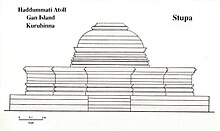
Buddhism came to the Maldives at the time of Emperor Ashoka's expansion and became the dominant religion of the people of the Maldives until the 12th century AD. The ancient Maldivian Kings promoted Buddhism and the first Maldive writings and artistic achievements in the form of highly developed sculpture and architecture are from that period. Before embracing Buddhism as the way of life Maldivians practiced ancient form of Hinduism, ritualistic traditions of a historical Vedic religion known as Śrauta in the form of venerating the Aditi, intertwined with the much earlier religion based on Sun worship (the ancient ruling cast were of Aadheetta or Suryavanshi origins).
The first archaeological study of the remains of early cultures in the Maldives began with the work of H.C.P. Bell, a British commissioner of the Ceylon Civil Service. Bell was shipwrecked on the islands in 1879, and returned several times to investigate ancient Buddhist ruins. He studied the ancient mounds, called havitta or ustubu (these names are derived from chaitiya or stupa) (Dhivehi: ހަވިއްތަ) by the Maldivians, which are found on many of the atolls. Although Bell asserted that the ancient Maldivians followed Theravada Buddhism, many local Buddhist archaeological remains now in the Malé Museum in fact also display elements of Mahayana and Vajrayana iconography.

In the early 11th century, the Minicoy and Thiladhunmathi, and possibly other northern Atolls, were conquered by the medieval Chola Tamil emperor Raja Raja Chola I, thus becoming a part of the Chola empire.
According to a legend from the Maldivian Folklore, in the early 12th century AD a medieval prince named Koimala nobleman of the Lion Race from Ceylon, sailed to Rasgetheemu island (literally Town of the Royal House or figuratively King's Town) in North Maalhosmadulu Atoll and from there to Malé and established a kingdom. By then, the Aadeetta (Sun) Dynasty (Suryavanshi ruling cast) had for some time ceased to rule in Malé, possibly because of invasions by the Cholas of Southern India in the Tenth Century. Koimala Kalou (Lord Koimala), who reigned as King Maanaabarana, was a king of the Homa (Lunar) Dynasty (Chandravanshi ruling cast), which some historians call the House of Theemuge.The Homa (Lunar) dynasty sovereigns inter-married with the Aaditta (Sun) Dynasty. This was why the formal titles of Maldive kings until 1968 contained references to "kula sudha ira" which means "descended from the Moon and the Sun". No official record exists of the Aadeetta dynasty's reign. Since Koimala's reign, the Maldive throne was also known as the Singaasana (Lion Throne).[33] Before then, and in some situations since, it was also known as the Saridhaaleys (Ivory Throne).[34] Some Historians accredit Koimala of freeing the Maldives from Tamil Chola rule.
Several foreign travellers, mainly Arabs, had written about a kingdom of the Maldives ruled over by a queen. This kingdom pre-dated Koimala's reign. al-Idrisi, referring to the writings of earlier writers, mentions the name of one of the queens, Damahaar, who was a member of the Aadeetta (Sun) dynasty.
The conversion to Islam is mentioned in the ancient edicts written in copper plates from the end of the 12th century AD. There is also a locally well-known legend about a foreign saint (an Azeri from the city of Tabriz) who subdued a demon known as Rannamaari. Dhovemi Kalaminja who succeeded Koimala converted to Islam in the year AD 1153.
Over the centuries, the islands have been visited and their development influenced by sailors and traders from countries on the Arabian Sea and the Bay of Bengal. The main export of medieval Maldivians was cowrie shell, which they cultivated by floating branches of coconut palms in the sea, to which the shells attached themselves.
The Maldives were the first landfall for traders from Basrah, sailing to Sri Lanka or Southeast Asia. In the Maldives, ships could take on fresh water, fruit and the delicious, basket-smoked red flesh of the black bonito, a delicacy exported to Sindh and China and Yemen. The people of the archipelago were gentle, civilised and hospitable. They produced brass utensils as well as fine cotton textiles, exported in the form of sarongs and turban lengths. These local industries must have depended on imported raw materials.
The other essential product of the Maldives was coir, the fibre of the dried coconut husk. Cured in pits, beaten, spun and then twisted into cordage and ropes, coir’s salient quality is that it is resistant to saltwater. It stitched and rigged the Dhows that plied the Indian Ocean. Maldivian coir was exported to Sindh, China, Yemen and the Persian Gulf.
“It is stronger than hemp,” wrote Ibn Battuta, “and is used to sew together the planks of Sindhi and Yemeni Dhows, for this sea abounds in reefs, and if the planks were fastened with iron nails, they would break into pieces when the vessel hit a rock. The coir gives the boat greater elasticity, so that it doesn’t break up.”
Colonial Influences, Independence the Republic
Although governed as an independent Islamic sultanate from 1153 to 1968, the Maldives was a British protectorate from 1887 until 25 July 1965.On December 16, 1887 the Sultan of the Maldives signed a contract with the British Governor of Ceylon turning the Maldives into a British protectorate, losing her sovereignty in matters of foreign policy. The British government promised the Maldives military protection and non-interference in local administration in exchange for an annual tribute paid by the Maldives. In 1957 the British established a RAF base in the strategic southernmost atoll of Addu for £2000 a year, where hundreds of locals were employed. Fiscal feasibility in question, 19 years later the British government decided to give up the base, as it was too expensive to maintain.

In 1953, there was a brief, abortive attempt to form a republic, but the sultanate was re-imposed. In 1959, objecting to Nasir's centralism, the inhabitants of the three southernmost atolls protested against the government. They formed the United Suvadive Republic and elected Abdullah Afeef as president and Hithadhoo as capital of this republic.
The agreement giving the Maldives full political independence was signed on behalf of His Majesty the Sultan by Ibrahim Nasir Rannabandeyri Kilegefan, Prime Minister; and on behalf of Her Majesty the Queen by Sir Michael Walker, British Ambassador designate to the Maldive Islands. The Ceremony took place at the British High Commissioner's Residence in Colombo on 26 July 1965. After independence from Britain in 1965, the sultanate continued to operate for another three years under King Muhammad Fareed Didi. On 11 November 1968, the monarchy was abolished and replaced by a republic under the presidency of Ibrahim Nasir, although this was a cosmetic change without any significant alteration in the structures of government. The official name of the country was changed from Maldive Islands to the Maldives. Tourism began to be developed on the archipelago by the beginning of the 1970s.
However, political infighting during the '70s between President Nasir's faction and other popular political figures led to the 1975 arrest and exile of elected prime minister Ahmed Zaki to a remote atoll. Economic decline followed the closure of the British airfield at Gan and the collapse of the market for dried fish, an important export. With support for his administration faltering, Nasir fled to Singapore in 1978, allegedly with millions of dollars from the treasury.
Maumoon Abdul Gayoom began his 30-year role as President in 1978, winning six consecutive elections without opposition. His election was seen as ushering in a period of political stability and economic development in view of Gayoom's priority to develop the poorer islands. Tourism flourished and increased foreign contact spurred development in the islands. However, his rule is controversial, with some critics saying Gayoom was an autocrat who quelled dissent by limiting freedoms and political favoritism.[35]
A series of coup attempts (in 1980, 1983, and 1988) by Nasir supporters and business interests tried to topple the government without success. While the first two attempts met with little success, the 1988 coup attempt involved a roughly 200-person force of the PLOTE Tamil militant group who seized the airport and caused Gayoom to flee from house to house until the intervention of 1600 Indian troops airlifted into Malé restored order.
In November 1988, a group of Maldivians headed by Muhammadu Ibrahim Lutfee, a small time businessman, used Tamil mercenaries from Sri Lanka to stage a coup against President Gayoom. After an appeal by the Maldivian government for help, the Indian military intervened against the mercenaries in order to reinstate Gayoom in power. On the night of 3 November 1988, the Indian Air Force airlifted a parachute battalion group from Agra and flew them non-stop over 2,000 kilometres (1,200 mi) to the Maldives. The Indian paratroopers landed at Hulule and secured the airfield and restored the government rule at Malé within hours. The brief, bloodless operation, labelled Operation Cactus, also involved the Indian Navy.
2004 Tsunami

On 26 December 2004, following the 2004 Indian Ocean earthquake, the Maldives were devastated by a tsunami. Only nine islands were reported to have escaped any flooding,[citation needed] while fifty-seven islands faced serious damage to critical infrastructure, fourteen islands had to be totally evacuated, and six islands were destroyed. A further twenty-one resort islands were forced to close because of serious damage. The total damage was estimated at more than 400 million US dollars, or some 62 percent of the GDP.[citation needed] A total of 108 people, including six foreigners, reportedly died in the tsunami.[35] The destructive impact of the waves on the low-lying islands was mitigated by the fact there was no continental shelf or land mass upon which the waves could gain height. The tallest waves were reported to be 14 feet (4.3 m) high.[citation needed]
Road to modern democracy
Violent protests in 2004 and 2005 led to a series of reforms to the country. The protests were organized by current president Mohamed Nasheed and his party. Internal and international pressure forced then-President Gayoom to legalize political parties and improve the democratic process. Multi-party, multi-candidate elections were held on 9 October 2008, with 5 candidates running against Gayoom. A 28 October runoff election between Gayoom and Nasheed resulted in a 54-percent majority for Nasheed and his vice-president candidate Dr. Waheed. A former journalist and political prisoner, Nasheed was a staunch critic of the Gayoom regime. In a speech prior to handing over power to his successor on 11 November 2008, Gayoom said: "I deeply regret any actions on my part ... (that) led to unfair treatment, difficulty or injustice for any Maldivian." At the time, Nasheed was detained and imprisoned several times since the age of 20, for heavy criticisms against Gayoom's administration and its officials in relation with election frauds and high profile corruption. Nasheed was tortured and treated inhumanly in detention. Gayoom was the longest serving leader of any Asian country.[35]
Mohamed Nasheed became the first President to be elected by a multi-party democracy in the Maldives, and Dr. Waheed was the first elected Vice President in the Maldives. Their election victory ended the 30-year dictatorship of President Gayoom.
Politics

Maldives is a presidential republic, with the President as head of government and head of state. The President heads the executive branch and appoints the cabinet which is approved by the People's Majlis (Parliament). Following the introduction of a new constitution in 2008, direct elections for the President take place every five years, with a limit of two terms in office for any individual. The current President is Mohamed Nasheed. Members of the unicameral Majlis serve five-year terms, with the total number of members determined by atoll populations. At the 2009 election, 77 members were elected.
Prior to 2008, Maldives did not have a constitution which guaranteed fundamental human rights. For 30 years, from 1978 until 2008, Maumoon Abdul Gayoom was president of the country. During the later part of his rule, independent political movements emerged in Maldives, which challenged the then-ruling Dhivehi Rayyithunge Party (Maldivian People's Party) and demanded democratic reform. These movements brought about significant change in the political structure of the Maldives. In 2008 a new constitution was approved and the first direct presidential elections occurred, which were won by Mohamed Nasheed and Dr. Mohammed Waheed Hassan (as Vice-President) in the second round. The 2009 parliamentary election saw the Maldivian Democratic Party of President Nasheed receive the most votes with 30.81%, gaining 26 seats, however the Dhivehi Rayyithunge Party with 24.62% of the vote received the most seats (28).
Despite the passage from monarchy to republic, the contemporary political structure shows a continuity with the feudal past in which power was shared among a few families at the top of the social structure. In some islands, the offices have remained within the same family for generations. In the modern day, the village is ruled by an administrative officer called Katību, who serves as the executive headman of the island. Above the Katībus of every atoll is the AtoỊuveriya (Atoll Chief). The power of these local chiefs is very limited and they take few responsibilities[citation needed]. They are trained to report to the government about the situation in their islands and to merely wait for instructions from the central power and to follow them thoroughly. Although islands are of considerably long distances from the governing capital, administrative rights over the lawmaking body of a particular island is withheld to a minimum, hence centralizing representatives from islands to a general parliament; the People's Majlis located in Male' which houses members from all over the country.[36]
Party Politics
The new government of President Mohamed Nasheedh faces restoring the economic downturn after 2004 tsunami coupled by overspending (by means of overprinting of local currency Ruffiya) during the last days of Maumoon regime, addressing concerns for the effect of global warming on the future of the islands, unemployment, government corruption, and increasing drug use, especially among youth. On 10 November 2008, Nasheed announced an intent to create a sovereign wealth fund with money earned from tourism that could be used to purchase land elsewhere for the Maldives people to relocate should rising sea levels due to climate change inundate the country. The government is reportedly considering locations in Sri Lanka and India due to cultural and climate similarities, and as far away as Australia.[35]
Administrative divisions
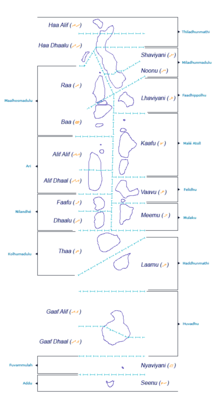
The Maldives has 7 provinces each consisting of the following administrative divisions (the capital Malé is its own administrative division):
- Mathi-Uthuru Province; consists of Haa Alif Atoll, Haa Dhaalu Atoll and Shaviyani Atoll.
- Uthuru Province; consists of Noonu Atoll, Raa Atoll, Baa Atoll and Lhaviyani Atoll.
- Medhu-Uthuru Province; consists of Kaafu Atoll, Alifu Alifu Atoll, Alifu Dhaalu Atoll and Vaavu Atoll.
- Medu Province; consists of Meemu Atoll, Faafu Atoll and Dhaalu Atoll.
- Medhu-Dhekunu Province; consists of Thaa Atoll and Laamu Atoll.
- Mathi-Dhekunu Province; consists of Gaafu Alifu Atoll and Gaafu Dhaalu Atoll.
- Dhekunu Province; consists of Gnaviyani Atoll and Addu City.
These provinces correspond to the historic divisions of Uthuru Boduthiladhunmathi. Dhekunu Boduthiladhunmathi, Uthuru Medhu-Raajje, Medhu-Raajje, Dhekunu Medhu-Raajje, Huvadhu (or Uthuru Suvadinmathi) and Addumulah (or Dhekunu Suvadinmathi).
The Maldives has twenty-six natural atolls and few island groups on isolated reefs, all of which have been divided into twenty-one administrative divisions (twenty administrative atolls and Malé city).[37]
In addition to a name, every administrative division is identified by the Maldivian code letters, such as "Haa Alif" for Thiladhunmati Uthuruburi (Thiladhunmathi North); and by a Latin code letter.
The first corresponds to the geographical Maldivian name of the atoll. The second is a code adopted for convenience. It began in order to facilitate radio communication between the atolls and the central administration. As there are certain islands in different atolls that have the same name, for administrative purposes this code is quoted before the name of the island, for example: Baa Funadhoo, Kaafu Funadhoo, Gaafu-Alifu Funadhoo. Since most Atolls have very long geographical names it is also used whenever the name of the atoll has to be quoted short, for example in the atoll website names.[38]
This code denomination has been very much abused by foreigners who didn't understand the proper use of these names and have ignored the Maldivian true names in publications for tourists.[39] Maldivians may use the letter code name in colloquial conversation, but in serious geographic, historical or cultural writings, the true geographical name always takes precedence. The Latin code letter is normally used in boat registration plates. The letter stands for the atoll and the number for the island.
Each atoll is administered by an Atoll Chief (Atholhu Veriyaa) appointed by the President. The Ministry of Atoll Administration and its Northern and Southern Regional Offices, Atoll Offices and Island Offices are collectively responsible to the President for Atolls Administration. The administrative head of each island is the Island Chief (Katheeb), appointed by the President. The Island Chief's immediate superior is the Atoll Chief.
The introduction of code-letter names has been a source of much puzzlement and misunderstandings, especially among foreigners. Many people have come to think that the code-letter of the administrative atoll is its new name and that it has replaced its geographical name. Under such circumstances it is hard to know which is the correct name to use.[38]
Demographics

The Maldivian ethnic identity is a blend of the cultures reflecting the peoples who settled on the islands, reinforced by religion and language. The earliest settlers were probably from southern India and Sri Lanka. They are linguistically and ethnically related to the people in the Indian subcontinent. They are ethnically known as Dhivehis.
Some social stratification exists on the islands. It is not rigid, since rank is based on varied factors, including occupation, wealth, Islamic virtue, and family ties. Traditionally, instead of a complex caste system, there was merely a distinction between noble (bēfulhu) and common people in the Maldives. Members of the social elite are concentrated in Malé. Outside the service industry, this is the only location where the foreign and domestic populations are likely to interact. The tourist resorts are not on islands where the natives live, and casual contacts between the two groups are discouraged.
A census has been recorded since 1905, which shows that the population of the country remained around 100,000 for the next sixty years. Following independence in 1965, the rate of population growth rose due to improved health status of the population. The population doubled by 1978, and the population growth rate peaked at 3.4% in 1985. By 2007, the population had reached 300,000, although the census in 2000 showed that the population growth rate had declined to 1.9%. Life expectancy at birth stood at 46 years in 1978, while it has now risen to 72 years. Infant mortality has declined from 127 per thousand in 1977 to 12 per thousand today, and adult literacy stands at 99%. Combined school enrollment stands in the high 90s.
As of April 2008, more than 70,000 foreign employees live in the country and another 33,000 illegal immigrants comprise more than one third of Maldivian population. They consist mainly of people from the neighboring South Asian countries of India, Sri Lanka, Bangladesh and Nepal.
Economy

In ancient times the Maldives were renowned for cowry shells, coir rope, dried tuna fish (Maldive Fish), ambergris (Maavaharu) and coco de mer (Tavakkaashi). Local and foreign trading ships used to load these products in Sri Lanka and transport them to other harbors in the Indian Ocean.
Historically Maldives provided enormous quantities of cowry shells, an international currency of the early ages. From the 2nd century AD the islands were known as the 'Money Isles' by the Arabs.[40] Monetaria moneta were used for centuries as a currency in Africa, and huge amounts of Maldivian cowries were introduced into Africa by western nations during the period of slave trade.[41] The cowry is now the symbol of the Maldives Monetary Authority.
The Maldivian government began an economic reform program in 1989, initially by lifting import quotas and opening some exports to the private sector. Subsequently, it has liberalized regulations to allow more foreign investment. Real GDP growth averaged over 7.5% per year for more than a decade. Today, the Maldives' largest industry is tourism, accounting for 28% of GDP and more than 60% of the Maldives' foreign exchange receipts. Fishing is the second leading sector.[citation needed]
The Maldivian economy is to a large degree based on tourism. In late December 2004, the major tsunami left more than 100 dead, 12,000 displaced, and property damage exceeding $400 million. As a result of the tsunami, the GDP contracted by about 3.6% in 2005. A rebound in tourism, post-tsunami reconstruction, and development of new resorts helped the economy recover quickly and showed an 18% increase on 2006. 2007 estimates show the Maldives enjoy the highest GDP per capita $4,600 (2007 est) amongst south Asian countries.
Tourism
The Maldives was largely terra incognita for tourists until the early 1970s. Strewn across the equator in the Indian Ocean, the Maldives archipelago possesses a truly unique geography as a small island country. Nature has fragmented the archipelago into 1,190 tiny islands that occupy a mere one per cent of its 90,000 km2 territory. Only 185 islands are home to its 300,000 population, while the other islands are used entirely for economic purposes of which tourism and agriculture are the most dominant. Tourism accounts for 28% of GDP and more than 60% of the Maldives' foreign exchange receipts. Over 90% of government tax revenue comes from import duties and tourism-related taxes.[citation needed] The development of tourism has fostered the overall growth of the country's economy. It has created direct and indirect employment and income generation opportunities in other related industries. The first tourist resorts were opened in 1972 with Bandos island resort and Kurumba Village.
According to the Ministry of Tourism website, the emergence of tourism in 1972 transformed the economy of the Maldives, moving rapidly from the dependence on the fisheries sector to the tourism sector. In just three and a half decades, the industry has become the main source of income and livelihood of the people of the Maldives. Tourism is also the country's biggest foreign currency earner and the single largest contributor to the GDP. Today, there are 89 resorts in the Maldives with a bed capacity of over 17,000, providing facilities for tourists whose annual arrival figure exceeds 600,000.[42]
The number of resorts has increased from 2 to 92 between 1972 and 2007. As of 2007, over 8,380,000 tourists had visited Maldives.[43]
Practically all visitors arrive at Malé International Airport, located on Hulhulé Island, which is next to the capital Malé. The airport is served by a wide array of flights to India, Sri Lanka, Doha, Dubai and major airports in South-East Asia, as well as an increasing number of charters from Europe. Many flights stop in Colombo (Sri Lanka) on the way.
Gan Airport, on the southern atoll of Addu, also serves an international flight to Milan several times a week.
Fishing industry

For many centuries the Maldivian economy was entirely dependent on fishing and other marine products. Fishing remains the main occupation of the people and the government gives special priority to the development of the fisheries sector.
The mechanization of the traditional fishing boat called dhoni in 1974 was a major milestone in the development of the fisheries industry and the country's economy in general. A fish canning plant was installed in the island of Felivaru[disambiguation needed] in 1977, as a joint venture with a Japanese firm. In 1979, a Fisheries Advisory Board was set up with the mandate of advising the government on policy guidelines for the overall development of the fisheries sector. Manpower development programs were begun in the early 1980s, and fisheries education was incorporated into the school curriculum. Fish aggregating devices and navigational aids were located at various strategic points. Moreover, the opening up of the Exclusive Economic Zone (EEZ) of the Maldives for fisheries has further enhanced the growth of the fisheries sector. Today, fisheries contribute over fifteen percent of the country's GDP and engage about thirty percent of the country's work force. It is also the second-largest foreign exchange earner after tourism.
Agriculture and Cottage industries
Agriculture and manufacturing continue to play a lesser role in the economy, constrained by the limited availability of cultivable land and the shortage of domestic labor. Most staple foods must be imported. Industry, which consists mainly of garment production, boat building, and handicrafts, accounts for about 7% of GDP.[citation needed] The development of the tourism sector gave a major boost to the country's fledgling traditional cottage industries such as mat weaving, lacquer work, handicraft, and coir rope making. New industries that have since emerged include printing, production of PVC pipes, brick making, marine engine repairs, bottling of aerated water, and garment production.
Judiciary

As a Republic the Constitution came into force in 1968 by a (and amended in 1970, 1972, and 1975) has been repealed and replaced by another Constitution assented to by the President Gayoom on 27 November 1997. This Constitution came into force on 1 January 1998. All stated that the president was the Head of State, Head of Government and the Commander-in-Chief of the Armed Forces and the Police of the Maldives. Under Intense pressure from the opposition a new Constitution was Ratified, dated 7 August 2008, whereby the power of judiciary was separated from the head of state.
According to the constitution of Maldives, "The judges are independent, and subject only to the constitution and the law. When deciding matters on which the Constitution or the law is silent, judges must consider Islamic Shari'ah."
The independent Judicial Services Commission is the core of the judiciary, who oversee the appointment and dismissal of judges, and act as a 'watchdog' to ensure that Judges uphold their own codes of conduct. Currently in an interim stage, one is appointed by the president other member from the Civil Service Commission, parliament, the public, high court judge, lower court judge and a supreme court member. Contradiction in the commission's makeup, which requires a Supreme Court member to be present on the commission, even though the Supreme Court must be composed with the advice of the commission.
There has been raised concerns over the independence of the commission, given that of eight interim members, the President appoints one and all current judges were appointed by President Maumoon Abdul Gayoom under the previous constitution, of them two were appointed to the commission.
The Supreme Court of Maldives is headed by a Chief Justice, who is the head of judiciary. Right now at an interim stage the President appointed 5 judges, who were approved by the Parliament. The interim court will sit until a new permanent Supreme Court is nominated under the constitution. Underneath the Supreme Court sit a High Court and a Trial court. The constitution requires uneven number rulings in the High Court of Maldives, therefore three justices are appointed. Any verdict there must be reached by a majority, but must also include a 'minority report'.
As part of the newly independent judiciary a Prosecutor General is appointed, who is responsible for initiating court proceedings on behalf of the government, will oversee how investigations are being conducted and have a say in criminal prosecutions, duties previously held by the Attorney General. Also has the power to order investigations, monitor detentions, lodge appeals and review existing cases. The Prosecutor General of Maldives is appointed by the President and has to be approved by the Parliament.
The Maldives have, in cooperation with the United Nations Development Programme (UNDP), undertaken to write the world's first Muslim criminal code. This project would formalize the proceedings of criminal justice in this tiny nation to one of the most comprehensive modern criminal codes in the world. The code has been written and awaits action by the parliament.
Religion
Islam is the only official religion of The Maldives. The open practice of all other religions is forbidden and such actions are liable to prosecution under the law of the country. A small but growing number of Maldivians do question their faith, using the internet as a means of communication but rarely in a public way.[44] According to the revised constitution, in article two, it says that the republic "is based on the principles of Islam." Article nine says that "a non-Muslim may not become a citizen of the Maldives"; number ten says that "no law contrary to any principle of Islam can be applied in the Maldives." Article nineteen states that "citizens are free to participate in or carry out any activity that is not expressly prohibited by sharia or by the law."

The requirement to adhere to a particular religion and prohibition on public worship in other religions is contrary to Article 18 of the Universal Declaration of Human Rights and Article 18 of the International Covenant on Civil and Political Rights to which the Maldives has recently become party[45] and was thus addressed in the Maldives' reservation in adhering to the Covenant claiming that "The application of the principles set out in Article 18 of the Covenant shall be without prejudice to the Constitution of the Republic of the Maldives."[46]
The Maldives is one of the countries which tops the government restrictions index on religious freedom.
Military of Maldives
The Maldives National Defense Force (MNDF) is a combined security force responsible for defending the security and sovereignty of the Maldives, having the primary task of being responsible for attending to all internal and external security needs of the Maldives, including the protection of the Exclusive Economic Zone (EEZ).
The MNDF component branches are the Coast Guard, the Fire & Rescue Service, Infantry Services, Defence Institute for Training & Education (Training Command), and Support Services.
Coast Guard
As a water-bound nation much of the security concerns lie at sea. Almost 90% of the country is covered by sea and the remaining 10% land is scattered over an area of 415 km (258 mi) x 120 km (75 mi), with the largest island being not more than 8 km2 (3 sq mi). Therefore the duties assigned to the MNDF of maintaining surveillance over Maldives' waters and providing protection against foreign intruders poaching in the EEZ and territorial waters, are immense tasks from both logistical and economic view points. Hence, for carrying out these functions, it is the Coast Guard that plays a vital role. To provide timely security its patrol boats are stationed at various MNDF Regional Headquarters.
Coast Guard is also assigned to respond to the maritime distress calls and to conduct search and rescue operations in a timely manner. Maritime pollution control exercises are conducted regularly on an annual basis for familiarization and handling of such hazardous situations.
Coast Guards also undertake armed sea transport of troops and military equipment around the country.
The Indian Ocean Commission

Since 1996, the Maldives has been the official progress monitor of the Indian Ocean Commission. Since 2002, the Maldives has expressed interest in the work of the Indian Ocean Commission but has not applied for membership. The interest of the Maldives relates to its identity as a small island state, especially in relation to matters of economic development and environmental preservation, and its desire to forge close relations with France, a main actor in the IOC region. The Maldives is a founding member of the South Asian Association for Regional Cooperation, SAARC, and as former protectorate of Great Britain, joined the Commonwealth in 1982, some 17 years after gaining independence from Great Britain. The Maldives enjoys close ties with Seychelles and Mauritius, who like the Maldives are members of the Commonwealth. The Maldives and Comoros are also both members of the Organisation of Islamic Conference. The Maldives has refused to enter into any negotiations with Mauritius over the demarcation of the maritime border between the Maldives and the British Indian Ocean Territory, pointing out that under international law, the sovereignty of the Chagos Archipelago rests with the UK, with whom negotiations were started in 1991.
Language and culture

Maldivian culture is heavily influenced by geographical proximity to Sri Lanka and southern India.
The official and common language is Dhivehi, an Indo-European language having some similarities with Elu, the ancient Sinhalese language. The first known script used to write Dhivehi is Eveyla akuru script which is found in historical recording of kings (raadhavalhi). Later a script called Dhives akuru was introduced and used for a long period. The present-day written script is called Thaana and is written from right to left. Thaana is said to be introduced by the reign of Mohamed Thakurufaanu. English is used widely in commerce and increasingly as the medium of instruction in government schools.
The language is of Indic Sanskritic origin, which points at a later influence from the north of the subcontinent. According to the legends, the kingly dynasty that ruled the country in the past has its origin there.
After the long Buddhist[47] period of Maldivian history, Muslim traders introduced Sunni Islam. Maldivians converted to Islam by the mid-12th century. The island has a long history of Sufic orders, as can be seen in the history of the country such as the building of tombs. They were used until as recent as the 1980s for seeking the help of buried Saints. They can be seen today next to some old mosques of the Maldives and are considered today as Cultural heritages. Other aspects of tassawuf, such as ritualized dhikr ceremonies called Maulūdu (Mawlid) -- the liturgy of which included recitations and certain supplications in a melodical tone—existed until very recent times. These Maulūdu festivals were held in ornate tents specially built for the occasion. At present Sunni Islam is the official religion of the entire population, as adherence to it is required for citizenship.
Since the 12th century AD there are also influences from Arabia in the language and culture of the Maldives because of the general conversion to Islam in the 12th century, and its location as a crossroads in the central Indian Ocean. This was due to the long trading history between the far east and the middle east. Somali pirates then later discovered the island for gold in the 13th Century before the Portuguese. Their brief stay later ended in a bloody conflict known by the Somalis as "Dagaal Diig Badaaney" in 1424.
According to Moroccan traveller Ibn Battuta, the person responsible for this conversion was a Sunni Muslim visitor named Abu al Barakat sailing from Morocco. However, more reliable Maldivian tradition says that he was a Persian saint from Tabriz called Yusuf Shamsuddin. He is also referred to as Tabrizugefaanu. His venerated tomb now stands on the grounds of the Friday Mosque, or Hukuru miski, in the capital of Malé. Built in 1656, this is the oldest mosque in Maldives.
Maldives' Firsts
- Maldives made a scuba diving record in 2006 for the largest number of scuba divers participating in one dive, with a grand total of 958 divers descending into the water at the same time. This record has since been overtaken by Indonesia in 2009.
- Maldives was the first country to open a virtual embassy, in the online world Second Life, on 22 May 2007.[48][49]
- Maldives was the first country to hold a cabinet meeting underwater. The cabinet meeting was chaired by President Mohamed Nasheed. In the meeting, the President, Vice President, and the cabinet signed a declaration calling for concerted global action on climate change, ahead of the UN climate conference in Copenhagen. The underwater meeting was part of a wider campaign by international environmental NGO 350.org.[50]


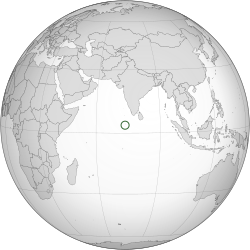

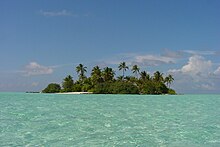

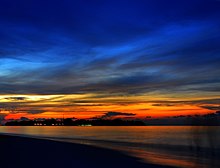
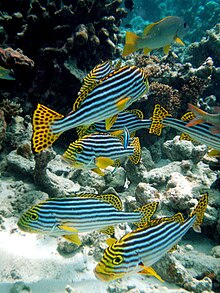


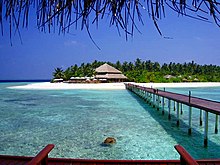


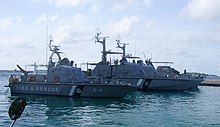


No comments:
Post a Comment